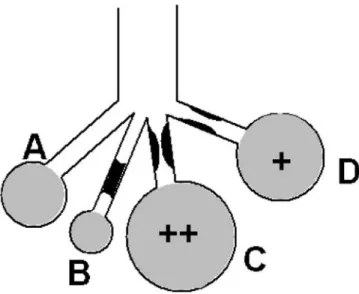Intensive Care Med (2006) 32:1664
DOI 10.1007/s00134-006-0296-1 C O R R E S P O N D E N C E
Mauro Oddo François Feihl
Reply to the comment
by Dr. Cole
Accepted: 26 June 2006
Published online: 22 August 2006 © Springer-Verlag 2006
This reply refers to the comment available at: http://dx.doi.org/10.1007/s00134-006-0297-0
The answer to Dr. Cole’s point must take into account the essential mech-anical heterogeneity of the acutely asthmatic lung. We agree that the
Fig. 1 Effect of variable amounts of airway obstruction on end-expiratory alveolar volumes and pressures
presence of “waterfall” dynamics cannot be excluded, as indeed could be the case in unit D (or part of it) in our Fig. 1. An external PEEP (PEEPe) level below the intrinsic PEEP of such units does not affect their volume if communication with the airway opening is maintained throughout expiration. A reduction in hyperinflation by PEEPe, as de-scribed in isolated case reports [1, 2], can occur only via suppression of a “ball-valve” obstruction (Fig. 1, unit C). Existence of the latter is favored, but not necessarily implied by flow-limitation in collapsible airways. Moreover, any gain achieved by PEEPe concerning the hyperin-flation of unit C might be offset by
aggravated distention of unit A, as well as any part of unit D not subject to expiratory flow limitation.
We do not mean to absolutely prohibit a prudent trial of external PEEP in acutely asthmatic ventilated patients, but, if at all performed, it should be quickly discontinued in absence of a clearly documented ben-efit in the form of reduced inflation pressures or improved hemodynamic status.
References
1. Qvist J, Andersen JB, Pemberton M, Bennike KA (1982) High-level PEEP in severe asthma. N Engl J Med 307:1347–1348
2. Mathieu M, Tonneau MC, Zarka D, Sartene R (1987) Effect of positive end-expiratory pressure in severe acute asthma. Crit Care Med 15:1164 M. Oddo (u)
Lausanne University Hospital CHUV, Department of Intensive Care Medicine, 1011 Lausanne, Switzerland
e-mail: Mauro.Oddo@chuv.ch F. Feihl
Lausanne University Hospital CHUV, Division of Clinical Pathophysiology, 1011 Lausanne, Switzerland
